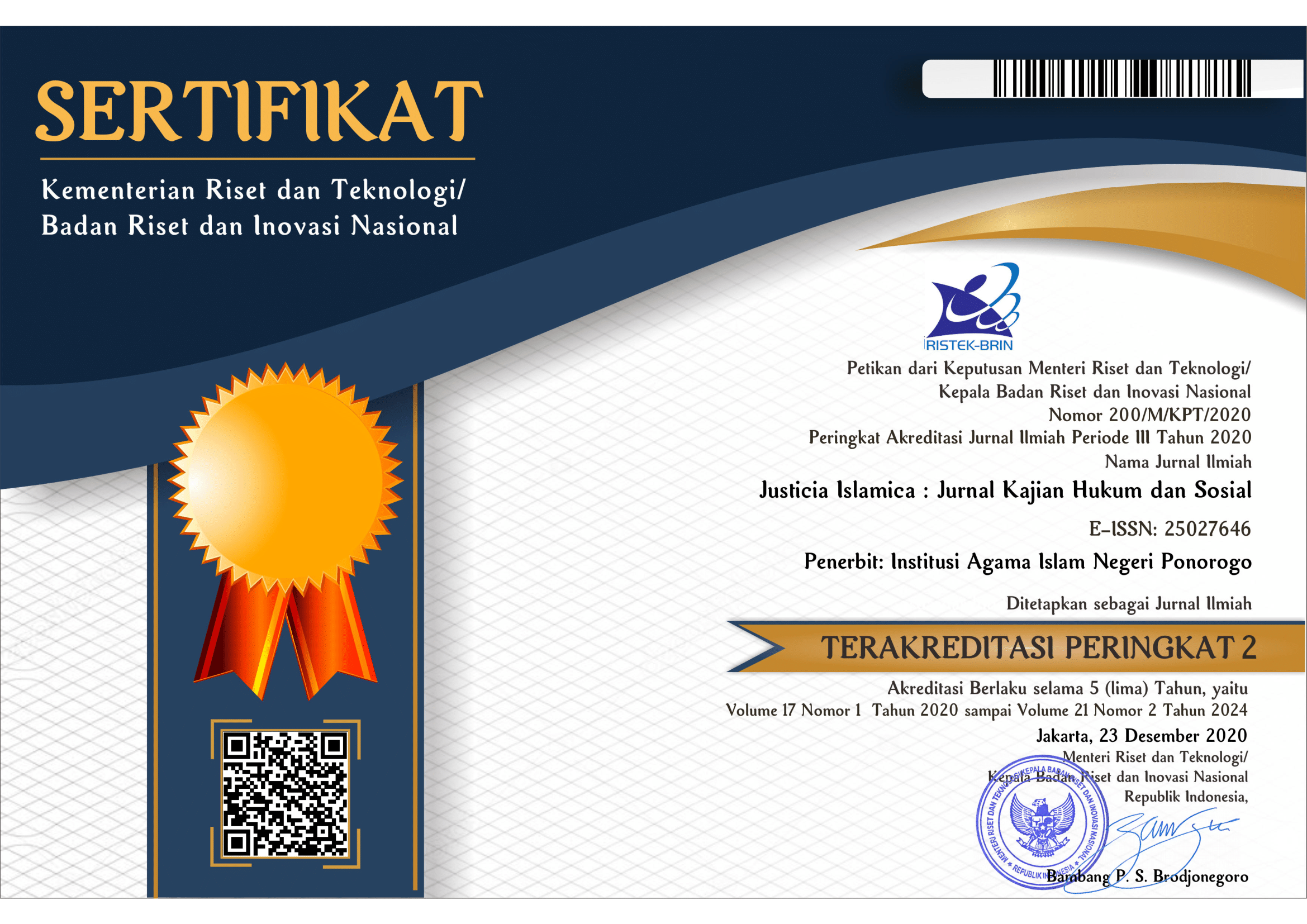Polygami Practices of Khulafa al-Rasyidin: A Classical Turast Study
DOI:
https://doi.org/10.21154/justicia.v16i2.1558Keywords:
Polygamy, Khulafa al-Rasyidin, Classical TurastAbstract
This paper aims to trace the practice of polygamy by the prophet's companions (khulafa al-rasyidin). Polygamy is part of Islamic teachings engraved in the Alquran and practiced by the Prophet Muhammad as written in history; besides that, the references of polygamy by Prophet Muhammad are straightforward to find, those have been written and translated into various languages in the world while the manuscript that explains about polygamy practices of Khulafa al-Rasyidin is still lacking. This paper is carried out with a historical normative approach by tracing the classical books (turast), while the data comes from primary and secondary data. From various classic references, it was found that the practice of polygamy carried out by Abu Bakar and Umar bin Khathab, no history was found; however, in some narrations, it is said that Umar bin Khathab and Abu Bakar had many wives, without explaining whether they were polygamous, divorced or caused by death. Unlike Ali bin Abi Thalib, he never practiced polygamy during his marriage to Fatimah. Usman bin Affan married two daughters of the Prophet, the first wife named Ruqayyah binti Rasulullah. After Ruqayyah died, Usman remarried Ummu Kaltsum binti Rasulullah. Usman never did polygamy while marrying the Prophet's daughter. Although Ali bin Abi Talib and Usman bin Affan did not mix the Prophet's daughters after they died, Ali and Usman remarried many women.
Tulisan ini bertujuan untuk menelusuri praktik poligami yang dilakukan oleh para sahabat nabi (khulafa al-rasyidin). Poligami merupakan bagian dari ajaran Islam yang terukir secara nyata dalam Alquran dan dipraktikkan oleh Nabi Muhammad saw sebagai mana yang ditorehkan dalam sejarah. Selain itu, sangat mudah ditemui referensi terkait praktik poligami nabi bahkan sudah ditulis dan diterjemahkan ke berbagai bahasa di dunia. Hal ini ternyata jauh berbeda dengan poligami yang di praktikkan oleh para sahabat nabi (khulafa al-rasyidin). Ini tentu menarik untuk dikaji karena sangat minimnya referensi terkait praktik poligami para sahabat nabi. Pendekatan yang digunakan dalam tulisan ini adalah normative historis dengan menelusuri kitab-kitab klasik (turast), sementara data yang digunakan berasal dari data primer dan data sekunder. Dari berbagai referensi yang penulis telusuri dalam kitab klasik, ditemukan bahwa praktik poligami yang dilakukan oleh Abu Bakar dan Umar bin Khathab, tidak ditemukan riwayat, hanya saja dalam beberapa riwayat dikisahkan bahwa Umar dan Abu Bakar mempunyai Istri yang banyak, tanpa menjelaskan apakah di poligami, dicerai atau ditinggal mati. Berbeda halnya dengan dua khalifah setelah mereka, Ali bin Abi Thalib misalnya, selama menikah dengan Fathimah tidak pernah melakukan praktik poligami. Begitu juga dengan Usman bin Affan yang menikahi dua putri Rasulullah, istri pertama bernama Ruqayyah binti Rasulullah, setelah Ruqayyah wafat Usman menikah lagi dengan Ummu Kaltsum binti Rasulullah, Usman tidak pernah melakukan poligami selama menikahi putri Rasulullah. Walaupun Ali bin Abi Thalib dan Usman bin Affan tidak memadu putri-putri Rasulullah, namun setelah mereka wafat Ali dan Usman menikah lagi dengan wanita lain dalam jumlah yang banyak.
Downloads
Published
How to Cite
Issue
Section
License
Requirements to be met by the author as follows:
- Author storing copyright and grant the journal right of first publication manuscripts simultaneously with licensed under the CC BY-SA allows others to share the work with a statement of the work's authorship and initial publication in this journal.
Authors can enter into the preparation of additional contractual separately for the non-exclusive distribution of a decadent version of the journal issue (e.g., post it to an institutional repository or publish it in a book), with the recognition of initial publication in this journal.
Authors are allowed and encouraged to post their work online (e.g., in institutional repositories or on their website) before and during the submission process because it can lead to productive exchanges and citations earlier and more severe than published works. (see The Effect of Open Access).
This work is licensed under CC BY-SA.


















